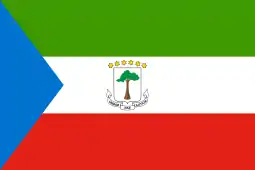Flag of Equatorial Guinea
The flag of Equatorial Guinea (Spanish: Bandera de Guinea Ecuatorial) was adopted on August 21, 1979.[1] The six stars on the map represent the country's mainland and five islands. Under the rule of dictator Francisco Nguema the flag was modified and a different national emblem was used in it. After he was deposed the original flag was restored.
 | |
| Use | Civil and state flag, civil and state ensign |
|---|---|
| Proportion | 2:3 |
| Adopted | August 21, 1979 |
| Design | A horizontal tricolor of green, white and red with a blue isosceles triangle based on the hoist side and the National Coat of arms of Equatorial Guinea centered in the white band. |
Features and symbolism
The flag is a horizontal tricolor, with green, white and red stripes and a blue triangle at the hoist. Green symbolizes the natural resources, agriculture and jungles of the country. Blue symbolizes the sea, which connects the main country with the islands. White symbolizes peace. Red symbolizes the blood shed by the fighters for independence.[2]
Colour schemes
(1979–present) |
Black | Blue | Green | White | Red | Gold |
|---|---|---|---|---|---|---|
| Pantone | Black | 293c | 355c | White | 032c | 051c |
| CMYK | 0-0-0-1 | 100-69-0-4 | 91-0-100-0 | 0-0-0-0 | 0-86-63-0 | 0-16-100-0 |
| RGB | 0-0-0 | 0-115-206 | 62-154-0 | 255-255-255 | 227-33-24 | 255-215-0 |
| Hexadecimal | #000000 | #0073CE | #3E9A00 | #FFFFFF | #E32118 | #FFD700 |
History
The flag was first flown the day of independence, October 12, 1968, and it showed the national emblem in the center. However, in 1973, during the regime of Francisco Nguema, a different national emblem was used on the flag. Under Nguema's rule, the coat of arm consisted of several tools, a sword and a chicken. The modified national motto Trabajo (work), and Unidad, Paz, Justicia (Unity, Peace, Justice) was written in two stripes.[3] The original coat of arms was restored after Nguema was deposed on 21 August 1979.[2] The arms consists of a silver shield with a silk-cotton tree, or Ceiba in the local language, which was derived from the arms of Rio Muni. Above the shield is an arc of 6 six-pointed yellow stars, that represent Rio Muni and the offshore islands. Beneath the shield is a silver scroll with the national motto, Unidad, Paz, Justicia ("Unity, Peace, Justice").[4] It is considered that under a silk-cotton tree a treaty was signed between Spain and a local ruler that marked the beginning of the colonial rule.[1]
.svg.png.webp) First flag (1968-73).
First flag (1968-73)..svg.png.webp) Second flag during the rule of Francisco Nguema (1973-79).
Second flag during the rule of Francisco Nguema (1973-79)..svg.png.webp) Flag after 1945 during Spanish Guinea.
Flag after 1945 during Spanish Guinea.
See also
References
- "National Flag of Equatorial Guinea". Worldflags. Retrieved 17 September 2014.
- Smith, Whitney (19 July 2013). "flag of Equatorial Guinea". Encyclopædia Britannica. Retrieved 17 September 2014.
- "Equatorial Guinea (1973 - 1979)". Crwflags.com. Retrieved 17 September 2014.
- Anjali Kamath. Flag Book. Popular Prakashan. p. 16. ISBN 978-81-7991-512-7.